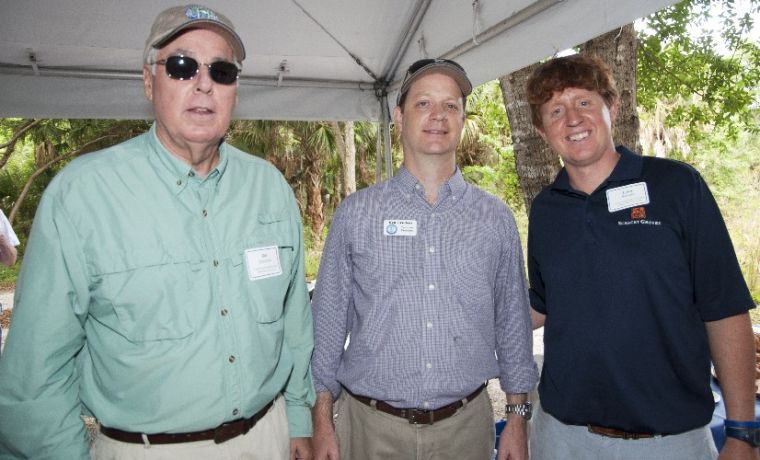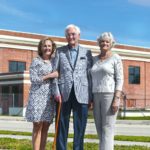
Members of the Indian River Land Trust gathered Saturday morning at the Toni Robinson Waterfront Trail to celebrate the successful completion of an ambitious goal to raise $10 million toward their capital campaign to Save Our Indian River Lagoon Acre by Acre.
“This is where it all started in 2009,” said Louis Schacht, Land Trust board chairman, noting that the 24-acre property was the first shoreline acreage purchased. “Toni goes back to the beginnings of the land Trust and I think it brings us full circle. Alma Lee may have her bridge but Toni has her trail!”
Boasting oak trees, scrub habitat and mangroves, an impoundment trail and a boardwalk extending out into the lagoon, the property is located in Winter Beach and open to the public.
It’s amazing what can happen in five years,” said Schacht. “Five years ago the Land Trust really didn’t own much property in the county at all. Five years ago we didn’t own this property. But at that time our board came together with a vision to start protecting land along the lagoon. And today, we’re proud to boast that we have protected nine miles of lagoon shoreline.”
The campaign began with a silent phase, with board members and staff raising the bulk of the funding from its members before eliciting support from the overall community.
“I want to thank the members for making this all possible,” said Schacht, noting they have raised more than $10.3 million.
As some guests enjoyed mouthwatering goodies from Patisserie, delicious orange juice from Schacht Groves and music by Blue Cypress Bluegrass band, others were busy making oyster mats, a project of the Vero Beach Power Squadron and Rotary Club, which will eventually help to improve water quality of the lagoon.
Nature’s do-it-yourselfers, mature oysters can filter up to 50 gallons of water a day, absorbing algae and pollutants and aiding in the recovery of their own natural habitat.
Ken Grudens, Land Trust executive director, thanked the various sponsors, particularly Charlotte Stifle and her son Henry, who are continuing the tradition of underwriting the event started by Charlotte and her late husband Hank.
“Once we started to focus on the lagoon, people really jumped on board and became advisors, board members and supporters,” said board member John Johnson.
A seasonal resident, Johnson has been involved with successful conservation efforts in Nantucket, and was recruited by Robinson to join the Land Trust board.
Timing is everything, and in this case the recession bolstered the Land Trust by depressing property values and making them more affordable for purchase by the Trust.
Johnson said the Trust began mapping undeveloped land, and contacted owners to see if they would be interested in selling. In 2009 there were a lot of willing sellers, but he realized that once the economy rebounded, waterfront property would again become prime real estate for developers.
“I pitched it to the board and said – now’s the time,” said Johnson. “You’ll never have an opportunity like this again.”
Additional shoreline Land Trust properties, some abutting other conservation areas, include 190 acres on Pine Island; four acres at Quay Dock Kayak Launch; the 51-acre Winter Beach Salt Marsh, the last in the county; the 1.5-mile, 206 acre Bridge View Property; Bee Gum Point, 111 acres along the migratory Atlantic Flyway; the Lagoon Greenway, a 187 acre trail system; and the southernmost 185-acre Coastal Oaks Preserve.
“Now we’re fitting in the little pieces,” said Johnson, noting that they are occasionally thwarted by owners overinflating values. He has also been asked whether the Land Trust has an ulterior motive to eventually sell the land at a profit.
“People don’t understand. We buy land for conservation, and it’s in conservation forever. We’re here to protect the land.”
Toni Robinson, the Land Trust’s first board president, credited the late Dorothy and Dan Mortensen with its first conservation effort – putting a halt to the bulldozing of the former McKee Jungle Gardens to make way for a shopping center.
“They called the Trust for Public Land, who told them, “You have to start giving tours.” We did and showed people what was going to happen,” said Robinson. “People joined in and said, “This can’t happen. They had to raise the money that year or they were going to start excavating.”
Robinson said she is often reminded of a speaker who said, “You can make things happen, you can watch things happen or you can wonder what happened.”
This group is clearly making things happen.






